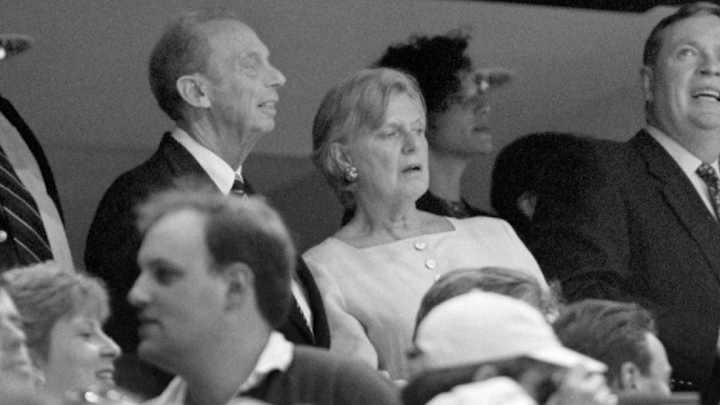Original Capitals Owner Irene Pollin Enjoying Team's Run in Stanley Cup Final

The morning after the Washington Capitals moved within one victory of claiming their first Stanley Cup, owner Ted Leonsis received a text message from the past:
YIKES
It was brief and cryptic by design. Even now, almost two decades after her late husband Abe sold the franchise to Leonsis for roughly $85 million cash, Irene Pollin still adheres to strict superstition. Anything more than five letters, she reasoned, might’ve upset the hockey gods and brought bad juju upon her city. Then again she also wanted Leonsis to understand how she was feeling after that 6-2 pasting of the Vegas Golden Knights, how her emotions still rise and fall with every goal and save. “Oh my god, I’m flooded,” she says. “I’m just flooded with memories.”
They have been rushing back with increasing speed during this magical postseason run, faster and faster as the Capitals climbed closer and closer toward their ultimate goal. At 93, Pollin remains sharp in both memory and wit. Reached on the phone at her Bethesda, Md., home this week, she spends a half-hour unspooling old stories about her time helping rear the NHL franchise—the couple did everything as complete partners, even if Abe received most of the credit—from its infancy.
How the Washington Capitals turned in—and recovered from—the worst NHL season ever
Forty-six years ago, the Pollins traveled to Montreal and attended an annual league meeting, hoping to convince its board of governors that Washington, D.C. deserved an expansion team. The competition was fierce and only one spot was available with another already promised to Kansas City. For three days and three nights, the Pollins lobbied around the clock. Irene vividly recalls staying up late in their hotel room, typing out telegrams in her bathrobe to solicit support from members of Congress, while Abe went door to door glad-handing voting representatives.
“The biggest overall argument against our getting the team was that Washington at the time was a backwater city when it came to hockey,” she would later write in Irene & Abe, an intimate memoir self-published in 2016. “A southern town where no one played hockey and therefore no one would be interested in watching professionals play the sport.”
While a massive longshot at first—Jimmy the Greek famously put the odds at 600-to-1 that the Pollins would succeed—today Irene can marvel at how far Washington has come. The land between 6th and 7th and F and G was boarded up and burnt down until the Pollins built what now stands as Capital One Arena, the raucous rock-the-red palace that has clocked more than 400 consecutive sellouts. Across the street, according to Irene, the director of the National Portrait Gallery didn’t even want fans parking there out of fear that it would cripple museum attendance; earlier this week, the front steps were flooded during watch parties for Games 3-4. “My husband’s dream was always to have it in the District,” she says.
Until December 1997, the team resided at Capital Centre in Landover, Md., a 17,962-seat arena that boasted a full-color video board capable of showing instant replay. “Prior to that, there was only one professional sports team and that was the football team,” Irene says. “There was no building that could have concerts or anything. So we kind of started from scratch.”
The same eventually proved true of the hockey team, whose 8-67-5 record during its inaugural ’74-75 season still stands as an NHL record for futility. “We had already been in professional sports, so we knew the ups and downs,” Irene says. (The Pollins also owned a majority stake in the Bullets-cum-Wizards from 1964 to 2010, a year after Abe’s death.) “It was a good night if both teams won. It was a bad night if both teams lost. It was a medium night if it was one and one. Then we would go get frozen custard on the way home to cheer us up.
“We ate a lot of frozen custard that year.”
It took eight more years until the Capitals finally reached the postseason, and then another 16 before they advanced beyond the second round. Irene still has Abe’s diamond-encrusted Eastern Conference championship ring from that ‘97-98 season, as well as a necklace emblazoned with her name. “I miss him now, just to talk about how great this is,” she says. “Which is so exciting. Especially when they kept saying hockey will never make it in Washington. And look at this team. It’s fantastic. It’s really beautiful to watch. It feels good.”
Restless legs: Behind the scenes with the Capitals on a back-to-back swing
The Pollins already experienced pro sports glory when the Bullets captured the ‘77-78 NBA championship—Irene fondly recalls their team plane touching down at the airport to a massive crowd of cheering supporters—but never quite got there in hockey. Asked how her late husband would react to current events, she replies, “He’d be in seventh heaven. He really would be.”
Perhaps Abe is indeed smiling down from above, tuning his television in the afterlife to watch Thursday night, the first of three chances for the Capitals to clinch the series. At her age Irene does not stay awake for entire games given their 8 p.m. EST puck drops, but she sleeps with a phone pressed against her pillow. It is the same cell that she uses to text Leonsis, not only after Game 4 but earlier during the Stanley Cup Final too:
THE BEST IS YET TO COME
